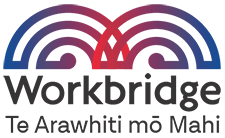Health and safety
Workbridge is the largest New Zealand-owned employment service for people with a disability or health condition.
- Occupational health and safety is a priority for every good employer and it is important that you take measures to ensure disabled employees are safe while at work.Many employers are concerned that disabled people will present a health and safety risk to themselves or to others in the workplace. In fact, disabled people are often more aware of their physical environment and choose to work in places where they are confident that they will be able to manage their disability and contribute to the business.
The Health & Safety at Work Act 2015 does not discriminate against those with disabilities or injuries, or the people who employ them.
The hazard management, training and accident reporting systems which you have in place as part of your normal operations will provide a good basis for safely accommodating any employees with disabilities.
To ensure that you have considered health and safety for disabled employees:
- check the workplace for obvious health and safety risks. WorkSafe NZ provides guidance in this area
- discuss health and safety with disabled employees. Ask whether there are particular elements of the workplace which cause additional problems for them and look at how these problems can be reduced. For example, people with vision impairments will benefit from extra care being taken to avoid clutter in the workplace; fluorescent lighting causes problems for some employees with epilepsy; heavy doors may be difficult to use for people with a range of mobility impairments
- provide workplace assessments for all staff and particularly those with disabilities or those who are experiencing discomfort. A workplace assessment can be undertaken by an occupational therapist, ergonomic consultant or other professional. They will watch an employee doing their job, assess potential risks and provide advice on working methods, posture, workstation design and assistive equipment
- check fire and emergency evacuation procedures, and ensure all employees are aware of them. People with mobility issues and wheelchair users will need an accessible exit route and a clear procedure for evacuation. This is particularly crucial for employees who are working above the ground floor where lifts may not be accessible in the event of an emergency. If you have Deaf or hearing impaired employees, a visual fire alarm (flashing light) should be within their line of sight. Make sure you are aware of any special requirements that disabled employees may have.
Absence related to musculoskeletal disorders is one of the biggest causes of lost productivity. Absences can be reduced by active management of health and safety in the workplace. For example, occupational overuse syndrome (OOS) is a common condition which can be avoided and successfully managed through ergonomic changes to the workstation, IT and other equipment.
In the majority of cases providing good health and safety management for disabled employees is the same for any employee.
